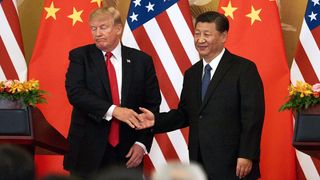American and Chinese negotiators have reached an in-principle "phase one" trade deal that will be signed in early January. The deal offers some relief from US tariffs in exchange for increased Chinese purchases of US agricultural products, but achieves few of the objectives the US set itself when it embarked on its costly trade war last year.
Most importantly, the deal sees the suspension of the 15 per cent tariff scheduled for imposition on $US160 billion ($233 billion) of Chinese imports by the US over the weekend.
It also cuts in half the 15 per cent tariff on $US120 billion of Chinese imports imposed on September 1. But it leaves in place the tariffs on $US250 billion in imports originally imposed at 10 per cent in 2018 and subsequently raised to 25 per cent.
The rollback of some of the existing tariffs was a key Chinese demand and an important concession from the US side, which had previously insisted existing tariffs would remain in place as a compliance and enforcement measure.
For its part, China has agreed to suspend its retaliatory tariffs that were also due to take effect over the weekend.
The rollback of some of the existing tariffs was a key Chinese demand and an important concession from the US side, which had previously insisted existing tariffs would remain in place as a compliance and enforcement measure.
The tariff suspension and rollback will benefit the US as much as China, although it still leaves US business and consumers paying the US Treasury billions of dollars per month in import taxes.
China has agreed to increase its imports of US goods and services by $US200 billion over the next two years compared with the amount it purchased in 2017, before the trade war began.
This includes $US32 billion in farm products over the next two years relative to a 2017 baseline. China said it would purchase corn, wheat and rice, which have not figured prominently in Chinese imports from the US in the past. The US side is still silent on the specifics.
The commitment to import more from the US raises major questions about how such a deal can be implemented and enforced. There is no indication China has backed away from its insistence that any purchases be demand-driven and consistent with World Trade Organization rules. Both considerations could provide China with a legitimate out from the deal.
While the deal includes a dispute resolution mechanism, any disagreements over implementation will just be added to the long list of differences between the US and China.
Moreover, the agreed dollar amounts could translate into a wide range of outcomes in terms of trade volumes, depending on what happens with commodity prices and exchange rates over the next two years.
It is also unclear to what extent US producers could satisfy the increased demand. Increased Chinese purchases may ultimately come at the expense of other customers.
The demand that China purchase more US goods and services is also somewhat at odds with the decoupling agenda promoted by some in the Trump Administration. If realised, it makes US producers more, not less, dependent on China and so increases China’s leverage in other elements of the trade conflict and strategic rivalry.
The phase one deal also includes commitments from China on intellectual property, technology transfer, market access and exchange rate management.
However, these measures mostly reflect steps China has already taken to improve its enforcement of intellectual property rights and foreign market access. These measures are in China’s interest and would likely have been taken in any event.
However, these commitments on paper will depend heavily on the extent to which they are enforced in China.
The phase one trade deal is smaller in scope than the deal that was on the table before China pulled back from negotiations in May this year and the in-principle agreement supposedly reached in October that has morphed into the limited deal to be signed in January.
President Trump will go into the US election year with very little to show for his costly trade war with China and the rest of the world.
The hard issues, such as China’s subsidies and directed lending to state-owned enterprises, have been consigned to a phase two deal unlikely to be concluded before the 2020 US presidential election, if ever.
The deal does little to alleviate the uncertainty caused by Donald Trump’s trade war. It is this uncertainty rather than the tariffs that has inflicted the most economic damage.
Tariffs remain Trump’s weapon of choice in US trade diplomacy. Because Congress has delegated much of its constitutional authority over trade to the President, there are few checks and balances on his use of the tariff weapon.
While the deal includes a dispute resolution mechanism, any disagreements over implementation will just be added to the long list of differences between the US and China.
President Trump will go into the US election year with very little to show for his costly trade war with China and the rest of the world.
Because his tariffs have inflicted as much economic damage on the US as they have on China, they actually weakened the US negotiating position, making Trump increasingly desperate for a superficial deal like this one to paper over the damage.






